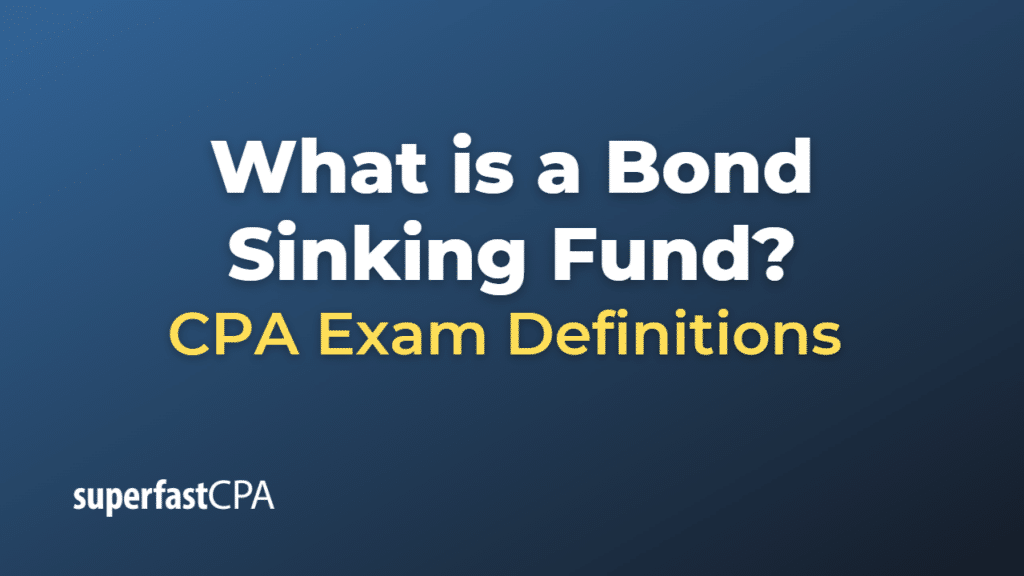Bond Sinking Fund
A bond sinking fund is a financial arrangement set up by a bond issuer, typically a corporation or governmental entity, to periodically set aside money to repay a portion of its outstanding bonds over time. The issuer creates a separate account for the sinking fund and makes regular payments into it. The accumulated funds are then used to purchase and retire a specified number of bonds either in the open market or through a lottery system, according to the terms of the bond indenture.
The primary purposes of a bond sinking fund are:
- Debt management: A sinking fund helps the issuer manage its debt obligations by gradually retiring bonds over their lifetime instead of facing a large lump-sum repayment at maturity. This approach can reduce the risk of default and make it easier for the issuer to meet its financial obligations.
- Creditworthiness: Establishing a bond sinking fund demonstrates the issuer’s commitment to repaying its debt, which can improve its creditworthiness and credit rating. A higher credit rating can lead to lower borrowing costs in the future.
- Interest rate risk: By retiring bonds periodically, the issuer can reduce its exposure to interest rate risk, especially in the case of callable bonds. If interest rates decrease, the issuer can retire bonds at a lower cost using the sinking fund.
- Investor confidence: A bond sinking fund provides additional security to bondholders by ensuring that the issuer has a plan to retire its debt obligations. This can make the bonds more attractive to investors, potentially leading to a lower yield and reduced borrowing costs for the issuer.
It is important to note that the terms and conditions of a bond sinking fund are outlined in the bond indenture, a legal document that governs the bond issuance. The bond indenture specifies the amount and frequency of sinking fund payments, the method of bond retirement (open market purchases or lottery), and any additional provisions or restrictions related to the sinking fund.
Example of a Bond Sinking Fund
Let’s consider a hypothetical example of a corporation using a bond sinking fund.
Suppose XYZ Corp., a manufacturing company, decides to issue 20-year corporate bonds to finance the expansion of its production facilities. The details of the bond issuance are as follows:
- Face value: $1,000 per bond
- Coupon rate: 5% per annum, paid semiannually
- Maturity date: 20 years from the date of issuance
- Total bonds issued: 5,000 bonds
- Sinking fund: Starting in the 5th year, XYZ Corp. will retire 250 bonds per year until the 20th year, using a sinking fund.
Here’s how the bond sinking fund works in this example:
- To establish the sinking fund, XYZ Corp. sets up a separate account and begins making periodic payments into it. The amount and frequency of the payments are determined by the bond indenture and the company’s cash flow projections.
- Starting in the 5th year, XYZ Corp. uses the accumulated funds in the sinking fund to retire 250 bonds per year. This can be done by purchasing the bonds in the open market or through a lottery system, as specified in the bond indenture.
- Over the 20-year life of the bonds, XYZ Corp. will retire a total of 5,000 bonds (250 bonds per year × 16 years) using the sinking fund.
- By the 20th year, when the bonds reach maturity, all of the outstanding bonds will have been retired, and XYZ Corp. will not face a large lump-sum repayment.
By using a bond sinking fund, XYZ Corp. can effectively manage its debt obligations and gradually retire its outstanding bonds over time. This approach reduces the risk of default, improves the company’s creditworthiness, and provides additional security to bondholders, potentially leading to a lower yield and reduced borrowing costs for the issuer.













